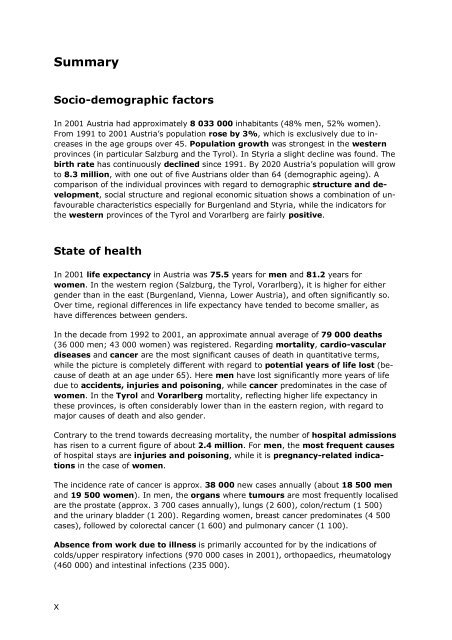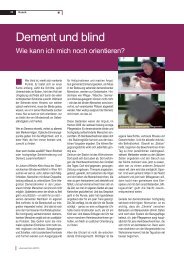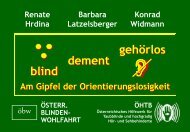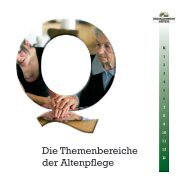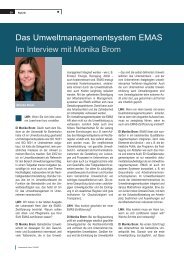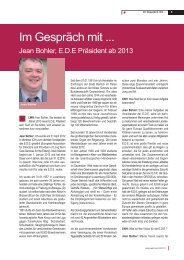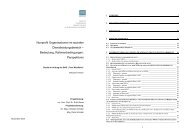Gesundheit und Krankheit in Österreich - Lebenswelt Heim
Gesundheit und Krankheit in Österreich - Lebenswelt Heim
Gesundheit und Krankheit in Österreich - Lebenswelt Heim
Erfolgreiche ePaper selbst erstellen
Machen Sie aus Ihren PDF Publikationen ein blätterbares Flipbook mit unserer einzigartigen Google optimierten e-Paper Software.
Summary<br />
Socio-demographic factors<br />
In 2001 Austria had approximately 8 033 000 <strong>in</strong>habitants (48% men, 52% women).<br />
From 1991 to 2001 Austria’s population rose by 3%, which is exclusively due to <strong>in</strong>creases<br />
<strong>in</strong> the age groups over 45. Population growth was strongest <strong>in</strong> the western<br />
prov<strong>in</strong>ces (<strong>in</strong> particular Salzburg and the Tyrol). In Styria a slight decl<strong>in</strong>e was fo<strong>und</strong>. The<br />
birth rate has cont<strong>in</strong>uously decl<strong>in</strong>ed s<strong>in</strong>ce 1991. By 2020 Austria’s population will grow<br />
to 8.3 million, with one out of five Austrians older than 64 (demographic age<strong>in</strong>g). A<br />
comparison of the <strong>in</strong>dividual prov<strong>in</strong>ces with regard to demographic structure and development,<br />
social structure and regional economic situation shows a comb<strong>in</strong>ation of unfavourable<br />
characteristics especially for Burgenland and Styria, while the <strong>in</strong>dicators for<br />
the western prov<strong>in</strong>ces of the Tyrol and Vorarlberg are fairly positive.<br />
State of health<br />
In 2001 life expectancy <strong>in</strong> Austria was 75.5 years for men and 81.2 years for<br />
women. In the western region (Salzburg, the Tyrol, Vorarlberg), it is higher for either<br />
gender than <strong>in</strong> the east (Burgenland, Vienna, Lower Austria), and often significantly so.<br />
Over time, regional differences <strong>in</strong> life expectancy have tended to become smaller, as<br />
have differences between genders.<br />
In the decade from 1992 to 2001, an approximate annual average of 79 000 deaths<br />
(36 000 men; 43 000 women) was registered. Regard<strong>in</strong>g mortality, cardio-vascular<br />
diseases and cancer are the most significant causes of death <strong>in</strong> quantitative terms,<br />
while the picture is completely different with regard to potential years of life lost (because<br />
of death at an age <strong>und</strong>er 65). Here men have lost significantly more years of life<br />
due to accidents, <strong>in</strong>juries and poison<strong>in</strong>g, while cancer predom<strong>in</strong>ates <strong>in</strong> the case of<br />
women. In the Tyrol and Vorarlberg mortality, reflect<strong>in</strong>g higher life expectancy <strong>in</strong><br />
these prov<strong>in</strong>ces, is often considerably lower than <strong>in</strong> the eastern region, with regard to<br />
major causes of death and also gender.<br />
Contrary to the trend towards decreas<strong>in</strong>g mortality, the number of hospital admissions<br />
has risen to a current figure of about 2.4 million. For men, the most frequent causes<br />
of hospital stays are <strong>in</strong>juries and poison<strong>in</strong>g, while it is pregnancy-related <strong>in</strong>dications<br />
<strong>in</strong> the case of women.<br />
The <strong>in</strong>cidence rate of cancer is approx. 38 000 new cases annually (about 18 500 men<br />
and 19 500 women). In men, the organs where tumours are most frequently localised<br />
are the prostate (approx. 3 700 cases annually), lungs (2 600), colon/rectum (1 500)<br />
and the ur<strong>in</strong>ary bladder (1 200). Regard<strong>in</strong>g women, breast cancer predom<strong>in</strong>ates (4 500<br />
cases), followed by colorectal cancer (1 600) and pulmonary cancer (1 100).<br />
Absence from work due to illness is primarily accounted for by the <strong>in</strong>dications of<br />
colds/upper respiratory <strong>in</strong>fections (970 000 cases <strong>in</strong> 2001), orthopaedics, rheumatology<br />
(460 000) and <strong>in</strong>test<strong>in</strong>al <strong>in</strong>fections (235 000).<br />
X


